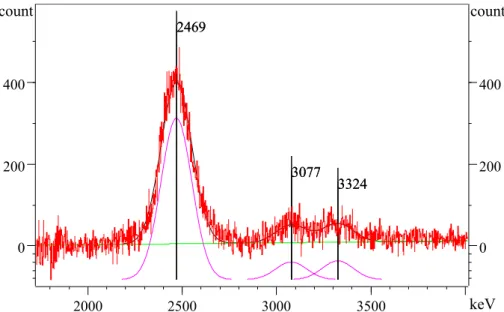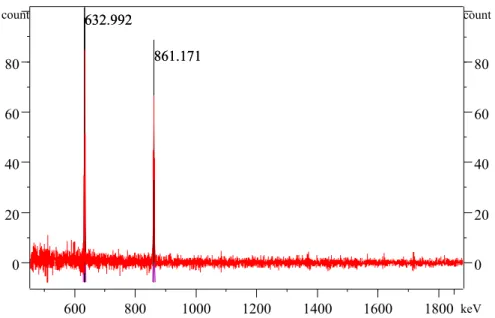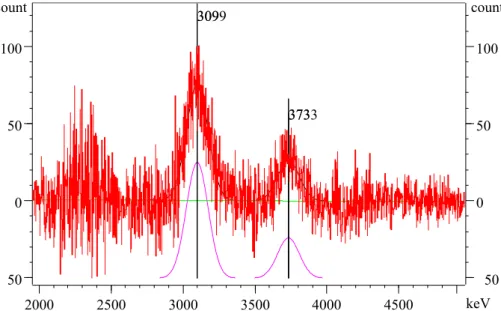γ -ray Spectroscopy of 106 Cd and a
Shell-Model based Deformation Analysis of
100−110 Cd Isotopes
Inaugural-Dissertation
zur
Erlangung des Doktorgrades
der Mathematisch-Naturwissenschaftlichen Fakultät der Universität zu Köln
vorgelegt von
Tobias Schmidt
aus Emsdetten
Köln
2019
Berischterstatter: Prof. Dr. Jan Jolie (Gutachter)
Prof. Dr. Alfred Dewald
Tag der mündlichen Prüfung: 23.08.2019
Zusammenfassung
Ein
106Cd(p, p
0γ) Streuexperiment wurde am FN-Tandembeschleuniger desInstituts für Kernphysik an der Universität zu Köln mit dem SONIC@HORUS- Spektrometer durchgeführt. Die Datenanalyse fokussierte sich auf eine detail- lierte
γ-Spektroskopie und die Bestimmung von Verzweigungsverhältnissender
γ-Strahlen. Zahlreiche neue Ergebnisse konnten gewonnen werden. Zu- sammengefasst wurden 64 neue
γ-Übergänge und 20 neue Anregungszustände entdeckt. Unstimmigkeiten zwischen vorangegangenen Arbeiten zur Untersu- chung von
106Cd konnten aufgelöst werden. Für acht Anregungszustände aus der Literatur (NNDC) wurde gezeigt, dass sie falsch platziert sind oder nicht existieren, 14 Verzweigungsverhältnisse konnten signikant korrigiert werden.
Das unbereinigte Spektrum von
106Cd wies eine hohe Dichte an
γ-Übergängen auf, erkennbar an der Entdeckung 23 neuer Multipletts von insgesamt 32 beob- achteten Multipletts. Dennoch konnten die Verzweigungsverhältnisse für jeden beobachteten
γ-Übergang bestimmt werden.
Starke Hinweise für ein Intruderband in
106Cd ergaben sich aus einem neu entdeckten Anregungszustand. Ein starkes Matrixelement, dass den Zustand mit dem Band verknüpft, konnte aus dem Verzweigungsverhältnis abgeschätzt werden. Durch die Einordnung dieser Ergebnisse zu bereits bekannten Ergeb- nissen der Nachbarisotopen, wird die Existenz eines
4+I-Intruderbandmitgliedes mit behauptet.
Die experimentellen Ergebnisse von
106Cd dieser Arbeit wurden mit Daten einer Schalenmodellberechnung verglichen, indem Levelschemata aus dem ex- perimentellen und dem theoretischen Datensatz gebildet wurden. Dabei wur- den Informationen über unveröentlichte mittlere Lebenszeiten aus einer neu- erlichen Analyse eines
106Cd(
n, n0γ)-Datensatzes mit den
γ-Verzweigungsver- hältnissen dieser Arbeit kombiniert.
Zusätzliche Schalenmodellberechnungen für die geraden Isotope
100−110Cd
wurden durchgeführt. Rotationsinvariante wurden aus den
B(E2)-Werten des
Schalenmodells für die Grundzustände dieser Kerne gewonnen. Die eektiven
Deformationsparameter
βef fund
γef fwurden zum ersten mal zusammen mit
ihren Varianzen
σ(β)und
σ(γ)aus Schalenmodelldaten abgeleitet. Die Ergeb-
nisse wurden mit Begriichkeiten von IBM-Symmetrien interpretiert. In die-
sem Zusammenhang wurde festgestellt, dass sich die Isotopenkette
100−110Cd
von einer
U(5)-artigen, Vibratorstruktur hin zu einem
O(6)-artigen, assyme-
trischen,
γ-soften Rotor gegen Mitte der Neutronenschale wandelt.Abstract
A
106Cd(p, p
0γ) experiment was performed at the FN tandem acceleratorat the Institute for Nuclear Physics at the University of Cologne, using the SONIC@HORUS spectrometer. The data analysis focused on a detailed
γ-ray spectroscopy and the determination of
γ-ray branching ratios. Numerous newresults could be obtained. In summary, 64 new
γ-transitions and 20 new levels were discovered. Discrepancies between former works, studying
106Cd could be solved. Eight levels stated in the literature (NNDC) were proven to be falsely placed or not existing, 14 branching ratios could be corrected signicantly. The singles spectrum of
106Cd exhibited a high density of
γ-rays, indicated by the discovery of 23 new multiplets among an overall observation of 32 multiplets.
Though, branching ratios could be obtained for every observed
γ-transition.
Strong hints for an intruder band in
106Cd are given by a newly discovered level. A strong matrix element connecting the state to the band could be estimated by the branching ratio. By classifying this results to known results of neighboring isotopes, a
4+Imember of the intruder band is suggested.
The experimental results of
106Cd of this work were compared to data of a shell-model calculation by the construction of level schemes from the experimental and theoretical data sets. Thereby, unpublished mean lifetime information from a recent analysis of a
106Cd(
n, n0γ) data set were combined with
γ-ray branching ratios of this work.
Additional shell-model calculations were performed for the even isotopes
100−110
Cd. Rotational invariants were extracted from shell-model
B(E2)- values for the ground states of these nuclei. The eective deformation pa- rameters
βef fand
γef f, including their variances
σ(β)and
σ(γ), were derived for the rst time from shell-model data. The results were interpreted in terms of IBM-symmetries. It was found in this context, that the chain of isotopes
100−110
Cd transform from a
U(5)-like, vibrator structure towards a
O(6)-like,
asymmetric,
γ-soft rotor at the middle of the neutron shell.
Contents
1 Introduction 1
2 γ -transitions in nuclei 5
2.1 Transition strength . . . . 5
2.2 Branching ratios . . . . 6
3 ( p, p
0) Experiment on
106Cd 8 3.1 Motivation . . . . 8
3.2 The SONIC@HORUS setup at the FN-Tandem Accelerator Cologne 8 3.2.1 Experimental settings and detector setup . . . . 8
3.2.2 Data acquisition and data processing . . . 10
3.3 Calibration . . . 11
3.3.1 Energy Calibration . . . 11
3.3.2 Eciency Calibration . . . 12
3.4 General data analysis methods . . . 14
3.5 Experimental Results . . . 15
4 Shell-Model Calculations and Comparison to experimental Data 52 4.1 The Nuclear Shell Model . . . 52
4.2 Shell-Model calculations of cadmium isotopes . . . 53
4.2.1 Comparison of level schemes for
106Cd . . . 54
5 Possible intruder band in
106Cd 58 6 A shell-model based deformation analysis of even Cd-isotopes 63 6.1 Deformation parameter . . . 63
6.2 Shape invariants . . . 64
6.3 Convergence study of invariants . . . 66
6.4 Deformation analysis . . . 72
7 Summary, conclusion, outlook 79
A Addition (p, p
0) -data analysis 81
B Addition to convergence study of rotational invariants 84
C Addition to deformation analysis 87
1 Introduction
Figure 1.1: The nuclear chart with a magnication of the region of the cadmium isotopes. Nuclei in red squares are part of a deformation analysis. Additionally, in green color
106Cd, which is spectroscopically analyzed by a (p, p
0) experiment. As can be seen, the cadmium nuclei lie in vicinity of the proton Z = 50 shell, while
98
Cd closes the neutron N = 50 shell. Figure adopted from Ref. [1].
The atomic nucleus is a complex quantum mechanical object. Understanding nuclear structure is still a matter of current research. The fact, that no exact analytical expression for the strong force acting between nucleons is at hand, points to the diculty of understanding the nuclear system in all its details. To get insights into the nuclear structure, it is crucial to have models of the nuclear system that allow satisfying predictions.
In the very beginning of the eld of nuclear physics, the liquid drop model of
Bethe and Weizesäcker [2] (1935) was derived. In this model the nuclear matter
is considered as a uid-like structure, in which nucleons behave more or less like
molecules in a droplet. This model was especially successful in predicting binding
energies of the nuclei. From this picture, A. Bohr and B. Mottelson developed their
geometrical collective model [3] (1953) with the concept that the nuclear droplet forms characteristic shapes. Nuclei were classied in vibrator or rotor types in which the nucleons perform collective motions accordingly. This foundational ap- proach allowed the prediction of level energies and transition strength, characteristic for each of the two types of collectivity. As the cadmium nuclei exhibited energy spectra typical for a harmonic vibrator, they became text-book examples for this case of collective motion [4, 5, 6] for many years based mostly on excitation energy information [7]. Figure 1.1 shows a magnication of the section of interest on the nuclear chart, where the light part of the cadmium chain can be seen close to the Z = 50 proton shell closure. The vicinity of the closed proton shell led furthermore to the assumption, that the cadmium isotopes exhibit a spherical shape. This addi- tionally supported the picture of a nuclear sphere undergoing harmonic vibrations [8]. The top of Figure 1.2 displays the level scheme of the harmonic vibrator as predicted by the geometrical model. Similarities to the experimental level distribu- tion of
112Cd, shown in the bottom of Figure 1.2, are apparent. Unlike presented in Figure 1.2, the information on transition strengths was very scarce until the 1990s [9, 10]. And as energy levels nicely matched to the predicted pattern of the har- monic vibrator, there was no doubt about the validity of this picture for many years.
Deviations in the level distribution and relative transition strengths were explained by anharmonicities of the vibrator [4, 5, 6].
Over time additional 0
+and 2
+states where discovered next to the two phonon triplet. These intruder states originate from particle hole excitations (2p-2h), where a proton pair (2p) gets placed across the Z = 50 major shell gap, leaving 2 proton holes (2h) in the Z = 28 − 50 shell. This results in 4 additional valence quasi- particles. The 2p-2h excitations are favored by the attractive quadrupole interaction of valence protons and neutrons, and thus the lowest excitation energies are found in the middle of the N = 50 − 82 neutron shell [8]. In the 1980s the idea of conguration mixing between the vibrational structure and the intruder states was introduced [11, 12, 13]. This approach could successfully explain anharmonicities and deviations in the relative transition strengths compared to the ideal vibrator as present in the cadmium isotopes. A rich description of dynamical symmetries in atomic nuclei thereby was founded in the mid 1990s. A, so-called, global coupling could be well established in the cadmium nuclei, in which a vibrational, U (5) -like, normal structure of states couples to a γ -soft, O(6) -like, intruder structure [14, 15, 16, 17]. The interacting boson model (IBM), which treats the nucleus as a composition of bosons, due to the likeliness of nucleons to couple to pairs of integer spin, is a profound tool for the analysis of this coupling mechanism. Its three symmetry limits provide descriptions for key structures of nuclear congurations, i.e the U (5) limit, the harmonic vibrator, the SU (3) limit, a deformed but rigid rotor and the O(6) limit, describing an asymmetric, γ -soft but rotational nucleus [8]. By analyzing the symmetry properties, a nucleus is placed between these three poles according to the parameters of the IBM-Hamiltonian. Yet the experimental knowledge about transition strengths was restricted mostly to the two-phonon levels.
Around 2010 the set of experimental information had grown, and information
about transition strengths for states considered to be three-phonon candidates was
available. Strong deviations from the vibrator picture were revealed, as can be
Figure 1.2: Top: The predicted level scheme including transition strengths relative to the B(E2; 2
+1→ 0
+1) transition. The summed transition strength of a n -phonon level is n times that of the 1-phonon transition.
Bottom: The experimental level scheme of
112Cd with B (E2) values normalized to the B(E2; 2
+1→ 0
+1) transition. Adopted Figures from [7].
seen by the relative transition strengths of
112Cd [7], as shown in Figure 1.2. The
picture of a vibrator conguration ( U (5) ), composed from so-called normal states,
that couples with a γ -soft, rotational ( O(6) ) intruder structure was tested for higher-
lying states. Garret et al. analyzed the decay patterns of
110−116Cd [18] (2008) up
to the three phonon level. They stated a breakdown of the picture of a strong-
mixing between the U (5) - and the intruder O(6) -structure for 0
+states at the two
phonon level for
116Cd, which casts doubt on the appropriateness of the vibrational
interpretation for any of the Cd isotopes. In a following work, Garret and Wood
[7] (2010) even rejected the low-energy vibrational modes in the Cd isotopes. They
ordered levels of
110−116Cd in band-like structures based on 0
+states, resulting in
an excitation pattern characteristic of quasi-rational bands. Additionally, newly
discovered non-neglectable quadrupole moments gave rise to the assumption that
the cadmium nuclei are not spherical, contradicting the spherical vibrator picture [7]. Heyde and Wood picked up the discussion in a review about shape coexistence [19] (2011), underlining the diculty in the interpretation of excited 0
+states in the Cd isotopes. In a detailed spectroscopic analysis of
110Cd Garrett et al. [20]
(2012) tested the intruder mixing scenario. They concluded that the non-intruder states are not vibrational in
110Cd, but the decay pattern is strongly suggestive of a γ -soft, or O(6) -type, nucleus.
Already in 2002, Gade et al. [21] stated that the nuclei
108−112Cd form a tran- sitional path between a vibrational, U(5) and a gamma-unstable O(6) dynamical symmetry, although with decreasing neutron number. Meaning a U (5) symmetry is stated at mid-shell. It is important to note, that this argumentation was founded solely on excitation energies of 0
+states. And, as already mentioned, at that time the picture of a U (5) -like symmetry at the middle of the shell was well accepted. In that same work, the rst observation of an intruder band in
108Cd was published.
Up to now, no intruder band is known in any lighter Cd nuclei.
This work contributes to the discussion, sketch above, by extending the focus
from the middle of the shell to the neutron decient side. The detailed spectroscopy
of
106Cd reveals many new results, i.e. γ -rays and levels, as well as branching
ratios. Strong hints for an intruder band are found in
106Cd. The shell model
analysis in this work extends a former work [22]. The nuclear shape of
100−110Cd
is analyzed with the method of rotational invariants. Higher order invariants are
derived from the shell-model data for the rst time, allowing a derivation of the
softness parameters σ(β) and σ(γ) . At the same time, a qualitative interpretation
about the symmetry development, in terms of the IBM, is possible. Starting from
shell-model calculations and deriving deformation parameters originating from the
geometrical model, an additional approach is available, that serves as crosscheck on
symmetry properties.
2 γ -transitions in nuclei
2.1 Transition strength
Excited nuclei obey the general decay law:
N = N
0e
−λt, (2.1)
which describes the number of excitations N over time t starting from N
0excitations.
The decay constant λ is related to the mean lifetime τ via λ = 1/τ = ln 2/t
1/2. The half life t
1/2is the time period after which half the number of initial excitations has decayed.
The constant λ can be determined by λ(σl, m) = 8π(l + 1)
l ~ (2l + 1)!!
ω c
2l+1|hf |O(σl, m)| ii|
2. (2.2) Equation 2.2 describes the transition probability of a γ -decay. σ denotes the electric or magnetic character E or M and l is the multipole order or the angular momentum carried by the γ -ray. The dierence in magnetic spin projection is m = m
i− m
fbetween initial and nal state. The energy of the γ -ray is related to ω and can be written as E
γ= ~ ω .
As Equation 2.2 gives the probability for a transition of one sub-state m = m
i− m
fto another, the sum over all possible substates m and m
fprovides the total transition strength, which determines the lifetime of the initial state. The matrix element in Equation 2.2 is therefore written as[23]:
B(σl, j
i→ j
f) = X
m,mf
|hj
fm
f|O(σl, m)| j
im
ii|
2. (2.3) The quantity B (σl, j
i→ j
f) is called the reduced transition probability or transition strength. Applying the Wigner-Eckart theorem, Equation 2.3 transforms to its well known form:
B(σl, j
i→ j
f) = 1
2j
i+ 1 |hj
fkO(σl)k j
ii|
2. (2.4) Values of B(σl) are given in units of e
2fm
2lor e
2b
lfor transitions with electric character and in µ
2Nfm
2l−2or µ
2Nb
l−1for magnetic transitions, with b (barn) = 10
−28m
2. It can be explicitly written [24]:
B(El) ↓ = ln 2 · l[(2l + 1)!!]
2~ 8π(l + 1)e
2b
l~ c E
γ 2l+11
t
1/2(El) , (2.5) B (M l) ↓ = ln 2 · l[(2l + 1)!!]
2~
8π(l + 1)µ
2Nb
l−1~ c
E
γ 2l+11
t
1/2(M l) . (2.6)
The downward arrow ↓ denotes transitions from an energetic higher level to a lower
level, t
1/2(σl) is the half life related to the decay.
Single particle estimate The operator in the single-particle Equation 2.4 can explicitly be written. For electric transitions the equation forms to [25]:
B(El, j
i→ j
f) = 1 2j
i+ 1
n
fl
fj
fr
lY
ln
il
ij
i2
˜ e e
2. (2.7)
The transition operator O(El) consists of a radial part r
land the spherical harmonics Y
l. The eective charge ˜ e can have values diering from the elementary charge e . Nuclear states are denoted by the oscillator quantum number n
i,f, the orbital spin l
i,fand the spin j
i,fof the state. Accordingly, the operator of magnetic transitions O(M l) in Equation 2.4 writes as:
O(M l) = ∇(r
lY
l) 1 e ×
1 l + 1
e e ~ mc l + µs e
, (2.8)
including the eective nuclear magnetic momentum µ e . Under the assumptions of a box function for the radial integral
r
land j
i= l +
12and j
f=
12in Equations 2.7 and 2.8, the transition strength can be expressed as [25]:
B
s.p.(El) = 1.2
2l4π ·
3 l + 3
2· A
2l/3[e
2fm
2l] (2.9) for electric transitions. The magnetic single particle estimate is written as:
B
s.p.(M l) = 10
π (1.2)
2l−2· 3
l + 3
2· A
(2l−2)/3[µ
2Nfm
2l−2] (2.10) Since the B
s.p.(σl) values of Equations 2.9 and 2.10 depend only on the nuclear mass A and the multipole order l , a xed estimate of the transitions strength orig- inating from a single particle orbit change can be calculated for every nucleus and decay multipolarity.
It is convenient to give transition strength, i.e. B(El) - and B(M l) -values, in units of Equations 2.9 and 2.10, in so-called Weisskopf units or W.u.. Depending on the structure of a nuclear state, transitions of several hundreds of W.u. can be ob- served, e.g. in strongly deformed rotational nuclei. Such strong transitions point to collective excitations, in which many nucleons contribute to form a state. The wave function of such states is an admixture of many single particle congurations with fractions of the mean occupation amplitude [25]. In contrast can a weak transition of ∼ 1 W.u. be classied to be of single particle character.
2.2 Branching ratios
By comparing both Equations 2.9 and 2.10, it is obvious that that for one and the
same multipolarity the electric transitions are favored by two orders of magnitude
relative to magnetic transitions. Complementary to the electromagnetic decay, a
state can deexcite by the emission of a conversion electron. Some nuclei can go
through complicated decay schemes involving even the emission of α -, β - and γ -
radiation as competing decay modes. The relative intensity of each decay channel
is called branching ratio [26]. In this work only relative γ -ray intensities have been measured, with the strongest intensity set to 100%, i.e. the sum of relative intensities related to one level exceeds 100%.
Competing decay channels i oer an enhanced ability for a state to get deexcited.
The half life of Equations 2.5 and 2.6 has to be corrected by [24]:
t
1/2= t
1/2(σl) · BR(γ
K) 1 + α
K, (2.11)
where BR(γ
K) is the total branching ratio of one γ -ray transition channel K , in-
cluding conversion electrons and α
Kdenotes the conversion coecient. In case of a
γ -transition with mixed multipolarity a factor of 1/(1 + δ
2) has to be added to the
right hand side of Equation 2.11 in case of equal multipole order l or δ
2/(1 + δ
2) for
l + 1 , where δ is the multipole mixing ratio.
3 ( p, p 0 ) Experiment on 106 Cd
3.1 Motivation
In the work of A. Linnemann [27] (2005) several experiments on
106Cd were con- ducted. Three experiments made use of the HORUS setup in Cologne (see Sec- tion 3.2.1) including the reactions:
104Pd( α , 2 n )
106Cd,
105Pd(
3He, 2 n )
106Cd and
106
Cd( p, n )
106In →
106Cd. Additionally, an inelastic neutron scattering experiment was performed at the University of Kentucky. The Van de Graa accelerator there was used to produce neutrons via a
3H( p, n )
3He reaction with a lower energy limit of 2.6 MeV. Level lifetimes were extracted by the Doppler shift attenuation method (DSAM) from the inelastic scattering reaction ( n, n
0)
106Cd. [27, 28].
The experiments of both setups did not yield the same results concerning certain newly discovered γ -rays and energy levels (commented on in Section 3.5). On top of that
106Cd was found to posses some unresolved γ -ray doublets in the post- processing of the neutron scattering data [29]. Due to these inconsistencies in γ -ray associations to levels and uncertainties in the branching ratios, the results of the neutron scattering experiment have not been published in a journal until the time of writing this thesis [29]. Results of other works studying
106Cd, that had been performed even before, could also not resolve these issues. In some cases, dierent results from literature are unclear or even contradict each other e.g. in stating branching ratios and γ -ray associations (see the discussion in Section 3.5).
The experiments by A. Linnemann [27] mentioned earlier were not equipped with particle detectors and lacked the ability to distinguish between level excitations co- incident with the registered γ -rays. A work of Kumpulainen et al. [30] (1992), using a
106Cd( p, p
0) reaction, includes particle and γ -ray detectors. The study focuses on level energies below 2.5MeV in the even isotopes
106−112,116Cd. Although the reaction and the ability to determine level excitations via the particle detectors are similar to this work, results of Kumpulainen et al. are not detailed enough to clarify some cases. For energies beyond 2.4 MeV, Ref. [30] can not be consulted. The SONIC [31] particle spectrometer, used in this work, is able to resolve excited levels.
Together with the HORUS [27] spectrometer, level excitations and γ -rays can be de- tected in coincidence. The aim of this work therefore is to achieve a most accurate spectroscopic picture of
106Cd and to solve the previously observed discrepancies.
3.2 The SONIC@HORUS setup at the FN-Tandem Acceler- ator Cologne
3.2.1 Experimental settings and detector setup
The FN tandem accelerator at the Institute for Nuclear Physics at the Cologne Uni- versity is capable to establish an accelerating voltage of up to 10MV. A 7.5 MeV pro- ton beam was provided with a mean current of 150mA. The calculated coulomb bar- rier lies at 7.7 MeV, as predicted by the code CASCADE[32]. The fusion-evaporation and inelastic-scattering reaction channels were calculated to be equally probable with
∼ 350 mb at 7.5 MeV. Other reaction channels are predicted to be in the neglectable
range of <0.7mb. Two self-supporting
106Cd targets were available with a thick-
Figure 3.1: Picture of SONIC@HORUS. The setup is opened, only one hemisphere of HORUS is visible carrying half of the 14 HPGe detectors surrounding SONIC in the center. The beam line goes from the left background to the right foreground.
Figure 3.2: (a): Schematic drawing of HORUS hosting 14 HPGe detectors placed at the corners and planes of a cube. Figure taken from [27].
(b): Scheme of SONIC housing 12 Si detectors placed in 3 ring of 4 detectors each.
Figure taken from [31].
ness of 0.9mg/cm
2and 1.2mg/cm
2and enrichments of above 70% and above 90%
respectively. The experiment was performed in August 2016 and lasted 7 days. The targets were swapped in the middle of the beam time.
The γ -rays were registered with the HORUS [27] cube spectrometer (High e- ciency Observatory for γ -Ray Unique Spectroscopy), equipped with 14 high purity Germanium (HPGe) detectors. Figure 3.2 (a) shows a scheme of HORUS. Six detec- tors are facing the planes of an imaginary cube and eight are pointing to the corners of the cube. Six of the detectors were equipped with BGO shields. A detailed description can be found in Ref. [27].
The SONIC [31] spectrometer (Silicon Identication Chamber) contains 12 Sili- con detectors placed in 3 rings of 4 detectors each at backwards angles towards the beam line direction. The solid angle coverage in backwards direction is 9%. Figure 3.2 (b) shows a scheme of SONIC. The spectrometer houses the target frame in its center, so that back scattered particles are registered by the Si-detectors.
Figure 3.1 shows a picture of the whole setup. The opened HORUS spectrometer is shown. Only one hemisphere holding 7 HPGe detectors is visible. In the center of HORUS the closed SONIC spectrometer is placed, integrated in the beam line.
The beam direction is from left to right.
3.2.2 Data acquisition and data processing
The detector signals are preamplied and processed by Digital Gamma Finder (DGF-4C) modules made by the company XIA LLC [33]. Each module has 4 in- put channels. Particle and γ -ray detector signals are digitized by the analog to digital converters (ADC) of the DGF modules. Each input channel is associated with a veto channel, which is used to directly reject a signal, if a corresponding BGO shield is attached and triggered. After the digitalization the amplitudes of de- tector signals correspond to uncalibrated channel numbers. Several DGF modules are synchronized by distributing the clock signal of a master module to the other modules. With this equipment, the data acquisition system (DAQ) is capable of rejecting signals if a required multiplicity of detector signals is not fullled. This way single events, that do not involve at least two detector signals necessary for γγ - and pγ -coincidence experiments, can be ignored. The multiplicity requirement was set to two during the experiment of this work. A detailed description of the DAQ can be found in Ref. [34].
The listmode les written by the DAQ were processed oine by the code SO- COv2 [35]. A crucial step is setting a time window for coincident detector events.
Additionally, a calibration can be handed to the code. Specic detector types can be set as event triggers. In this work, the particle detectors were set as trigger to ensure measured coincidences were stemming from a back scattered particle i.e.
events most likely originating from the target material were processed and back-
ground noise was reduced. From these input settings, SOCOv2 sorts event les
which are then processed in a second step to build two-dimensional matrices. For
the analysis, γγ -, pγ - and γp -matrices were build. By handing gate parameter for a
specic detector type to the code, the process of building the matrices is restrained
to events within the gate. An analysis of triple events is possible this way, although
the rst gate of the building process cannot be background corrected.
3.3 Calibration
3.3.1 Energy Calibration
-0.3 -0.25 -0.2 -0.15 -0.1 -0.05 0 0.05 0.1 0.15 0.2
0 500 1000 1500 2000 keV
Residual of energy peaks to values of Kumpulainen et al. in keV
Figure 3.3: Residual of energy values of peaks used for linear calibration to energies given in the work of Kumpulainen et al. [30].
Ge-Detectors A proper calibration of an experimental setup is a vital task for the analysis of γ -ray spectra. A common procedure is the measurement of a calibration source with the used detector setup shortly before or after the conducted experiment.
This way energy values can be assigned to the counting channels of the DAQ. In this work, a
226Ra calibration source was used, which is an established standard for this task [36].
226Ra has a half life of 1600 years before going through an α -decay. It is the starting point of a chain of α - and β
−-decays of signicantly shorter lifetimes, so that a sucient amount of γ -rays is provided from the daughter nuclei, spread over an energy range up to 3 MeV. Energy values of
226Ra have been taken from [36], which also provides relative intensities for the decay chain, allowing an eciency calibration of the detector setup.
A major problem in the calibration procedure, was a gain shifting in the detector
electronics over the whole beam time. In such cases, peaks are not present in the
same channels in each subrun, but rather shift their channel number, which results
in wrong energies and broad peaks after the calibration. This problem can be taken
into account by the SOCOv2 [35] sorting code, which provides tracking of peaks
separately for each detector starting at a given channel number from subrun to
subrun. The resulting shift polynomials from this step are processed during the
sorting procedure and are combined with the calibration polynomials handed to the
code. Afterwards the energy peak of each subrun match with those of the previous subruns. Unfortunately, a gain shift also happened in the electronics during the time period between the experiment and the measurement of the calibration source. The conducted energy calibration with the
226Ra source did thus not produce a satisfying assignment of energies to channels for the beam time. The spectra taken during the calibration were shifted about 2-10 keV compared to the spectra taken during the experiment. Therefore, the only detector with a nearly adequate calibration and a deviation to literature values of
106Cd [1] of 0.2 keV - 0.5 keV has been taken as a reference. The quadratic calibration polynomials of the detectors had to be manually modied, so that each detector matches the peak pattern of the reference detector.
That way it was possible to obtain a rst calibration of the setup. Non-linear energy shifts could be handled by this procedure. To further improve the calibration, energy values have been taken from the work of Kumpulainen et al. [30] and a linear correction has been conducted. Figure 3.3 shows the residual of the nal calibration to energy values given in Ref. [30]. The standard deviation of that residual gives an error of 0.09 keV, a value well below the energy uncertainty of 0.3 keV given in Ref. [30]. Therefore, an error of 0.3 keV for energy values has been adopted in this work. Note however that this second calibration was not handed to the sorting code SOCOv2, but was rather applied after the data analysis. Therefore, gures showing γ -spectra in this work may not display the resulting energies presented in Table 3.1.
It is emphasized that the deviation of energy values to the literature is starting to exceed the 0.3 keV energy uncertainty of this work from ∼ 2.3 MeV upwards. As one can see from Figure 3.3, the 2370 keV ground state transition reveals the beginning of this eect by an increasing deviation to the literature. Also, Table 3.1 displays some higher energetic ground state transitions, that do not match with the level energies. Thus, to get the most valid values, γ -rays beyond ∼ 2.3 MeV have not been taken into account in the calculation process of level energies.
Si-Detectors With the Ge-detectors calibrated, the Si-detectors can be calibrated from a p γ -matrix. By gating on γ -rays that can clearly be assigned to certain level energies, a single excitation can be observed in the p-spectra, which can in turn be associated to the level energy. The FWHM of peaks in the p-spectra is typically in the range of 180 keV (Figures 3.7 and 3.10 give an impression of the energy resolution.). After the calibration, peak centroids match with level energies in a range of ± 10 keV.
3.3.2 Eciency Calibration
Germanium-detectors are not equally sensitive to γ -radiation of dierent energy. As
the probability for Compton-scattering increases with energy, the probability for a
γ -ray to deploy its full energy in the detector crystal decreases. It is also more likely
for a γ -ray to pass through the crystal without interaction, i. e. the detector is less
ecient to γ -radiation with increasing energy resulting in an under representation
of higher energetic γ -rays in the count rates. Besides this intrinsic eciency, γ -ray
detection is also inuenced by the geometry of the setup i. e. the coverage of solid
angle by detector material, which is called the geometric eciency of the setup. The
0 0.2 0.4 0.6 0.8 1 1.2 1.4 1.6
0 500 1000 1500 2000 2500
Peak volume 226Ra in % normalized to strongest literature line at 609keV
keV Fit of efficiency function without upslope at low energy
Fit of efficiency function with upslope at low energy
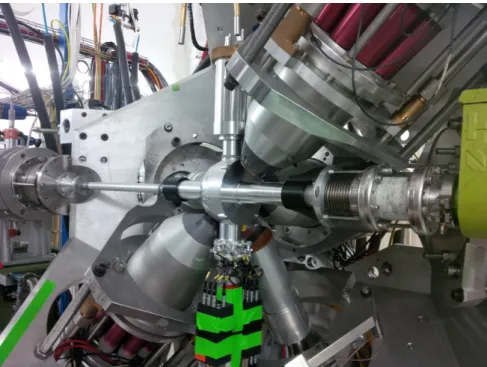
![Figure 3.4: Fit of the detector eciency function given in [37] to peak volumes of the 226 Ra calibration source with relative intensities > 4%](https://thumb-eu.123doks.com/thumbv2/1library_info/3701399.1506040/19.892.135.752.125.584/figure-detector-eciency-function-volumes-calibration-relative-intensities.webp)
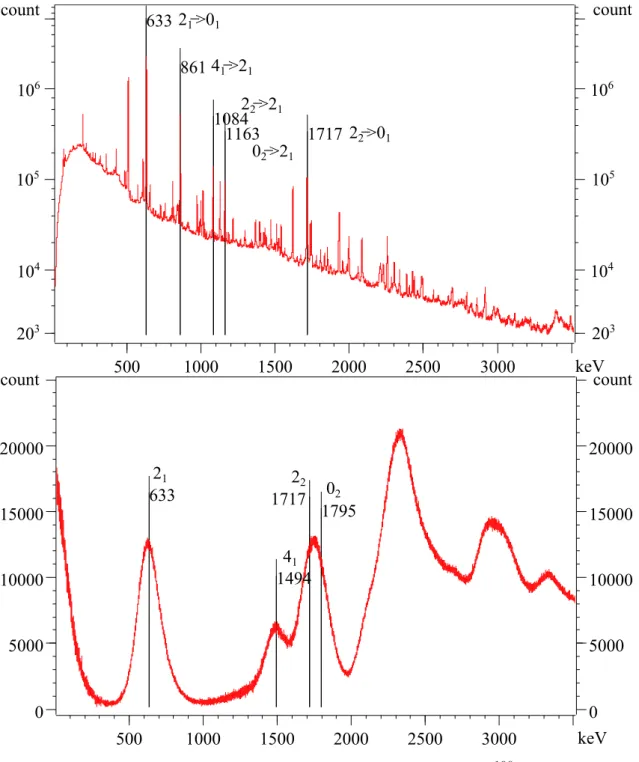
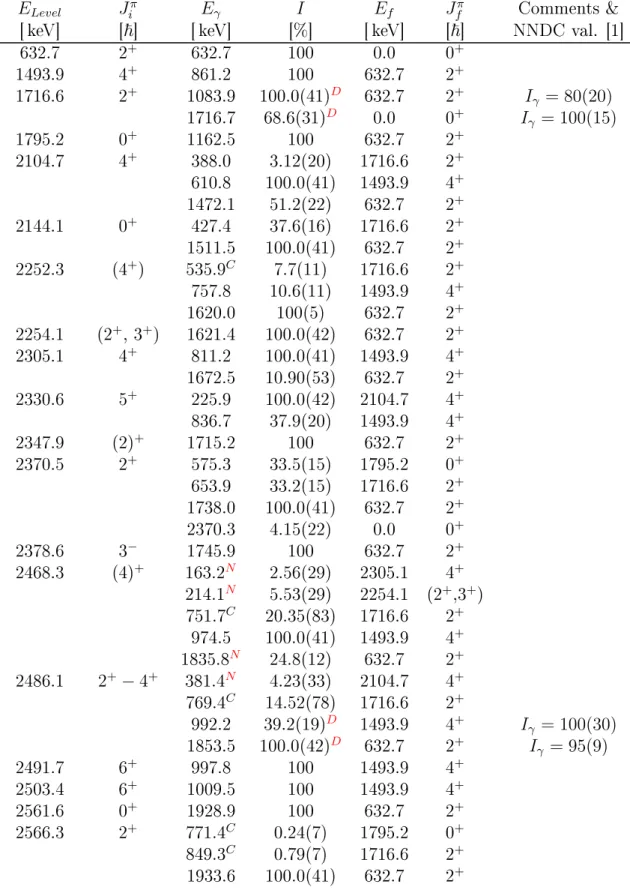
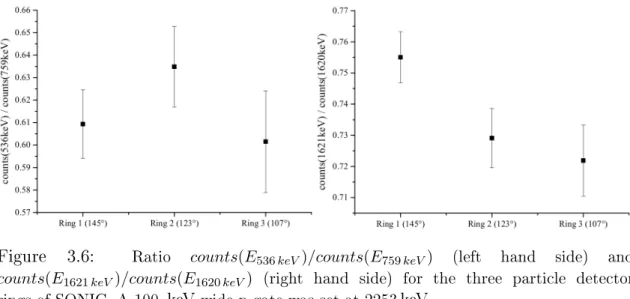
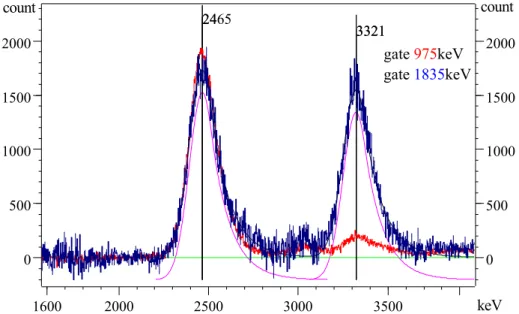
![Figure 3.10: Top: Particle spectrum, taken from Kumpulainen et al. [30]. A γ -gate was set to the 1715 keV/1717 keV doublet-peak in the (p, p 0 γ) -experiment in that work.](https://thumb-eu.123doks.com/thumbv2/1library_info/3701399.1506040/33.892.201.692.119.644/figure-particle-spectrum-taken-kumpulainen-gate-doublet-experiment.webp)
